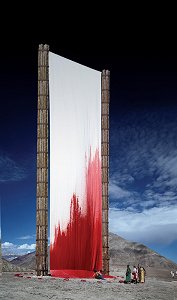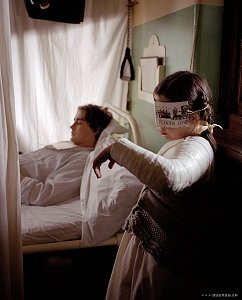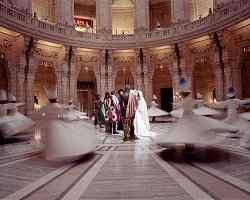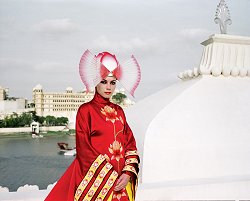 |
|
At The Picture Show
|
June 2008
A tale of two souls
Tarsem's 'The Fall' is an exceptional, surprising blend of intimate storytelling and bombastic visual experimentation

The Fall
Roadside Attractions
Director: Tarsem
Screenplay: Dan Gilroy, Nico Soultanakis and Tarsem, based on a 1981
screenplay by Valeri Petrov
Starring: Lee Pace, Catinca Untaru, Justine Waddell, Marcus Wesley, Jeetu
Verma, Robin Smith, Leo Bill and Daniel Caltagirone
Rated R / 1 hour, 57 minutes
Now playing in limited release



 (out of four)
(out of four)
It has been eight years since Tarsem released a feature film, and if that time has
taught him how to marry subject matter with his uncompromising visual style,
then it was worth the time . . . and the time was well-needed.
 Tarsem, a renowned commercial and music-video
director, made his feature directing debut in 2000 with The Cell, a pseudo-sci-fi
thriller about a psychiatrist who enters the subconscious of a serial killer to try to
save his next intended victim - and the killer's soul. It shifted back and forth
between her journey into his psyche - rendered with elaborate detail and majestic
visual design, its settings and colors growing darker and more threatening the
deeper the good doctor goes - and, in the real world, the laziest police procedural
you'll ever see.
Tarsem, a renowned commercial and music-video
director, made his feature directing debut in 2000 with The Cell, a pseudo-sci-fi
thriller about a psychiatrist who enters the subconscious of a serial killer to try to
save his next intended victim - and the killer's soul. It shifted back and forth
between her journey into his psyche - rendered with elaborate detail and majestic
visual design, its settings and colors growing darker and more threatening the
deeper the good doctor goes - and, in the real world, the laziest police procedural
you'll ever see.
Though its remarkable visuals were all you could possibly remember about the
film, everything outside the killer's brain made much of The Cell a chore to sit
through. As if Tarsem barely cared that there was a story going on.
Thankfully, that is not the case with The Fall, which, after premiering at the 2006
Toronto Film Festival, finally found a distributor this year.
Like the director's earlier effort, The Fall tells two different narratives. The base
story involves two inhabitants of a 1920 Los Angeles hotel - Roy (Lee Pace, of
the great ABC series Pushing Daisies), a paraplegic, and a young girl named
Alexandria (Catinca Untaru).
 The other story is a fantastical, epic tale of
betrayal, vengeance, adventure and romance - all the things that make the movies
worthwhile - that Roy unfolds to Alexandria to keep her company, pass the time
. . . and trick her into sneaking off to the forbidden areas of the hospital to steal
him some morphine pills. He's a jilted romantic whose idealism shattered with an
ill-fated grand, romantic gesture that left him paralyzed (unfortunate, when you're
a professional stuntman) and heartbroken, his great love now in the arms of
another man.
The other story is a fantastical, epic tale of
betrayal, vengeance, adventure and romance - all the things that make the movies
worthwhile - that Roy unfolds to Alexandria to keep her company, pass the time
. . . and trick her into sneaking off to the forbidden areas of the hospital to steal
him some morphine pills. He's a jilted romantic whose idealism shattered with an
ill-fated grand, romantic gesture that left him paralyzed (unfortunate, when you're
a professional stuntman) and heartbroken, his great love now in the arms of
another man.
His story is a tale of bitter revenge - a group of five men all after the head of the
same man, the one who ruined all their lives. The famous movie star who stole
Roy's special lady is, naturally, the villain in the tale, the appropriately odious
Governor Odious (Daniel Caltagirone).
What's surprising about The Fall is how well the two storylines complement each
other. One could assume that the hospital scenes would be merely an excuse to get
to the fantastical flights of fancy, but in fact the relationship that builds between
Roy and Alexandria - the two acting as each other's only human connection in an
otherwise dreary hospital - remains front and center.
 Only when the fantasy must necessarily coincide
with Roy and Alexandria's lives does it take over, and even then, it's because it
matters desperately to each of them how the story must end. How the story ends
holds great meaning to the fate of the two characters.
Only when the fantasy must necessarily coincide
with Roy and Alexandria's lives does it take over, and even then, it's because it
matters desperately to each of them how the story must end. How the story ends
holds great meaning to the fate of the two characters.
The scenes with Roy and Alexandria are warm and surprisingly funny. They try
their best to communicate despite her hit-or-miss English and his secret suicidal
tendencies. They negotiate the details of the story so it's just the way they want it.
They insert themselves into it. They create their heroes and villains out of their
fellow hospital inhabitants - doctors and patients alike.
The beautiful nurse whose emotions are impossible to detect? She's the disloyal
love interest. The kind, quiet orderly? He's Charles Darwin, reclusive genius and
one of our five heroes.
And so on.
Unlike The Cell, which took everyone's humanity - except for the serial killer
himself - for granted, with none of the characters getting beyond their role in the
plot, the most important conflict in The Fall is directly tied to who each of these
characters are.
 Without spoiling the circumstances, Roy and
Alexandria come into conflict over how the story should end. Their contrasting
opinions on the matter reveal their souls openly, and the conclusions the film
ultimately comes to are crucial in exploring both. In The Cell, you can see that the
decisions are being made by a lazy screenwriter. With The Fall, you feel they are
being made by the characters.
Without spoiling the circumstances, Roy and
Alexandria come into conflict over how the story should end. Their contrasting
opinions on the matter reveal their souls openly, and the conclusions the film
ultimately comes to are crucial in exploring both. In The Cell, you can see that the
decisions are being made by a lazy screenwriter. With The Fall, you feel they are
being made by the characters.
Of course, none of that should distract us from the most notable star of the film,
Tarsem himself. He self-financed The Fall and filmed intermittently over a couple
of years and in more than two-dozen countries.
The result is a cornucopia of eclectic settings, ostentatious costumes, gorgeously
colored landscapes and absurdly imaginative visual ideas. Only this time, all of
that serves something bigger. Both storylines are effective in and of themselves,
but neither is complete without the other.
Read more by Chris Bellamy